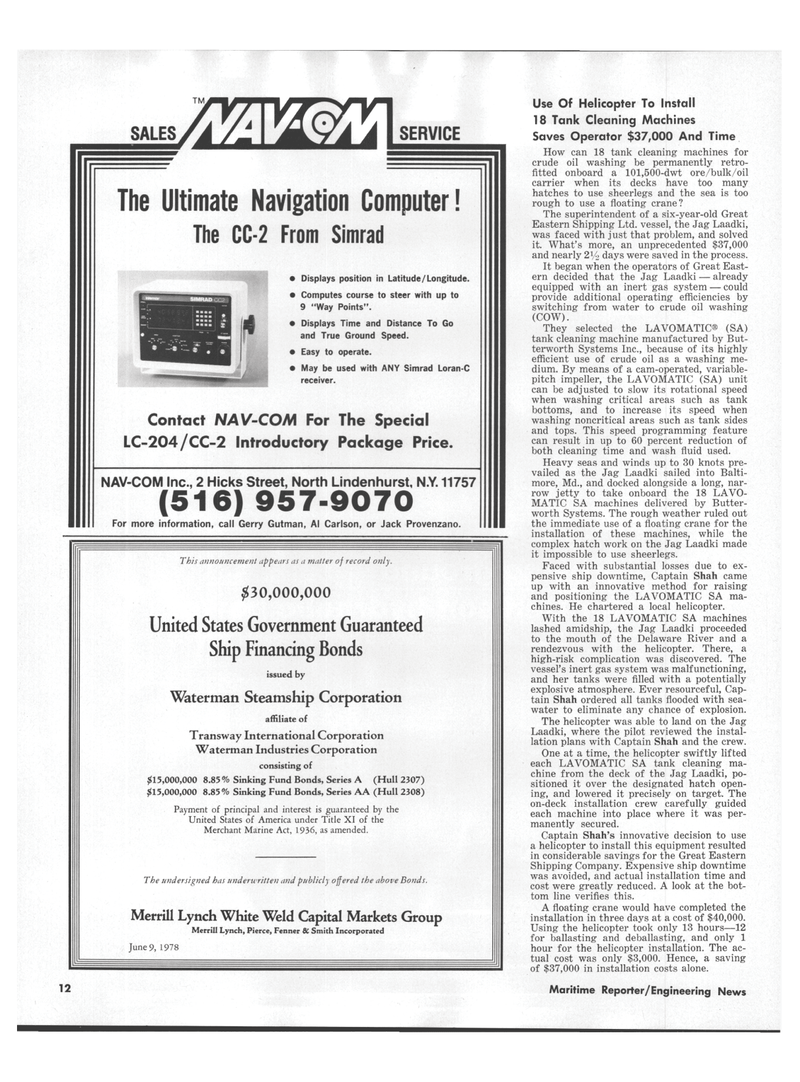
Page 10: of Maritime Reporter Magazine (August 1978)
Read this page in Pdf, Flash or Html5 edition of August 1978 Maritime Reporter Magazine
The Ultimate Navigation Computer!
The CC-2 From Simrad • Displays position in Latitude/Longitude. • Computes course to steer with up to 9 "Way Points". • Displays Time and Distance To Go and True Ground Speed. • Easy to operate. • May be used with ANY Simrad Loran-C receiver.
Contact NAV-COM For The Special
LC-204 /CC-2 Introductory Package Price.
NAV-COM Inc., 2 Hicks Street, North Lindenhurst, N.Y. 11757 (516) 957-9070
For more information, call Gerry Gutman, Al Carlson, or Jack Provenzano.
This announcement appears as a matter of record only. $30,000,000
United States Government Guaranteed
Ship Financing Bonds issued by
Waterman Steamship Corporation affiliate of
Transway International Corporation
Waterman Industries Corporation consisting of $15,000,000 8.85 % Sinking Fund Bonds, Series A (Hull 2307) $15,000,000 8.85% Sinking Fund Bonds, Series AA (Hull 2308)
Payment of principal and interest is guaranteed by the
United States of America under Title XI of the
Merchant Marine Act, 1936, as amended.
The undersigned has underwritten and publicly offered the above Bonds.
Merrill Lynch White Weld Capital Markets Group
Merrill Lynch, Pierce, Fenner 8C Smith Incorporated
June 9, 1978
Use Of Helicopter To Install 18 Tank Cleaning Machines
Saves Operator $37,000 And Time
How can 18 tank cleaning machines for crude oil washing be permanently retro- fitted onboard a 101,500-dwt ore/bulk/oil carrier when its decks have too many hatches to use sheerlegs and the sea is too rough to use a floating crane?
The superintendent of a six-year-old Great
Eastern Shipping Ltd. vessel, the Jag Laadki, was faced with just that problem, and solved it. What's more, an unprecedented $37,000 and nearly 2l/> days were saved in the process.
It began when the operators of Great East- ern decided that the Jag Laadki — already equipped with an inert gas system — could provide additional operating efficiencies by switching from water to crude oil washing (COW).
They selected the LAVOMATIC® (SA) tank cleaning machine manufactured by But- terworth Systems Inc., because of its highly efficient use of crude oil as a washing me- dium. By means of a cam-operated, variable- pitch impeller, the LAVOMATIC (SA) unit can be adjusted to slow its rotational speed when washing critical areas such as tank bottoms, and to increase its speed when washing noncritical areas such as tank sides and tops. This speed programming feature can result in up to 60 percent reduction of both cleaning time and wash fluid used.
Heavy seas and winds up to 30 knots pre- vailed as the Jag Laadki sailed into Balti- more, Md., and docked alongside a long, nar- row jetty to take onboard the 18 LAVO-
MATIC SA machines delivered by Butter- worth Systems. The rough weather ruled out the immediate use of a floating crane for the installation of these machines, while the complex hatch work on the Jag Laadki made it impossible to use sheerlegs.
Faced with substantial losses due to ex- pensive ship downtime, Captain Shah came up with an innovative method for raising and positioning the LAVOMATIC SA ma- chines. He chartered a local helicopter.
With the 18 LAVOMATIC SA machines lashed amidship, the Jag Laadki proceeded to the mouth of the Delaware River and a rendezvous with the helicopter. There, a high-risk complication was discovered. The vessel's inert gas system was malfunctioning, and her tanks were filled with a potentially explosive atmosphere. Ever resourceful, Cap- tain Shah ordered all tanks flooded with sea- water to eliminate any chance of explosion.
The helicopter was able to land on the Jag
Laadki, where the pilot reviewed the instal- lation plans with Captain Shah and the crew.
One at a time, the helicopter swiftly lifted each LAVOMATIC SA tank cleaning ma- chine from the deck of the Jag Laadki, po- sitioned it over the designated hatch open- ing, and lowered it precisely on target. The on-deck installation crew carefully guided each machine into place where it was per- manently secured.
Captain Shah's innovative decision to use a helicopter to install this equipment resulted in considerable savings for the Great Eastern
Shipping Company. Expensive ship downtime was avoided, and actual installation time and cost were greatly reduced. A look at the bot- tom line verifies this.
A floating crane would have completed the installation in three days at a cost of $40,000.
Using the helicopter took only 13 hours—12 for ballasting and deballasting, and only 1 hour for the helicopter installation. The ac- tual cost was only $3,000. Hence, a saving of $37,000 in installation costs alone. 12 Maritime Reporter/Engineering News

 9
9

 11
11
